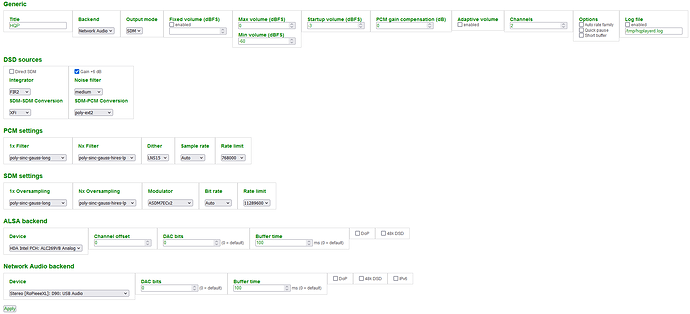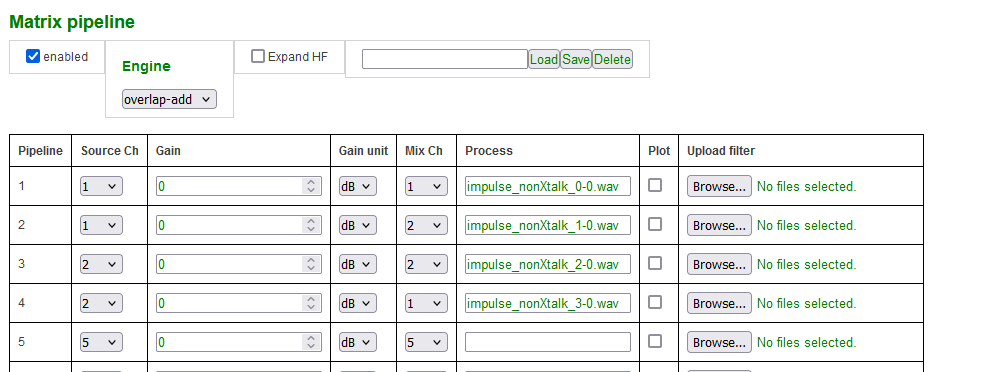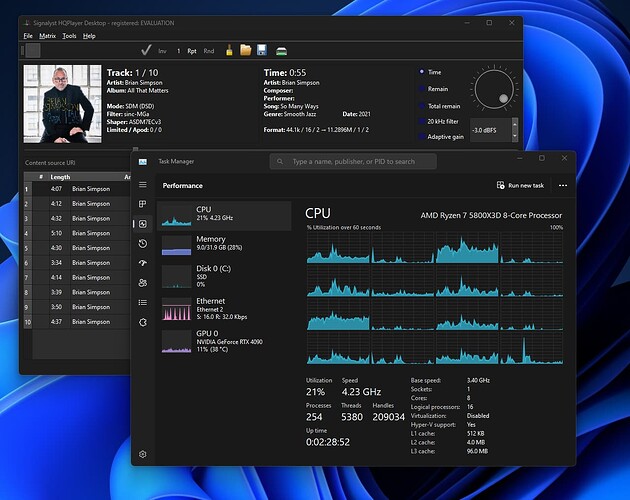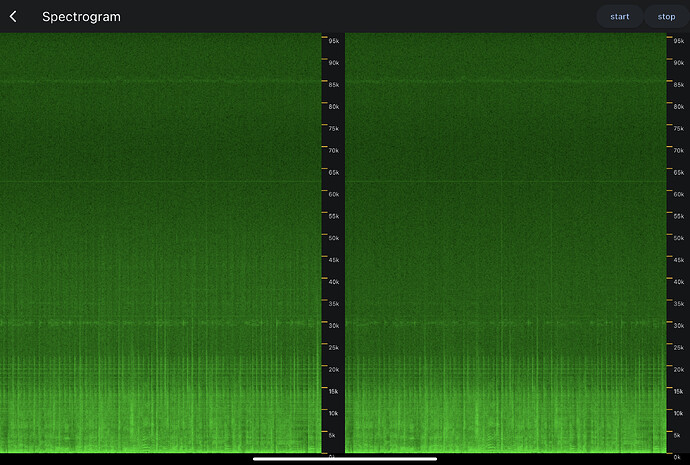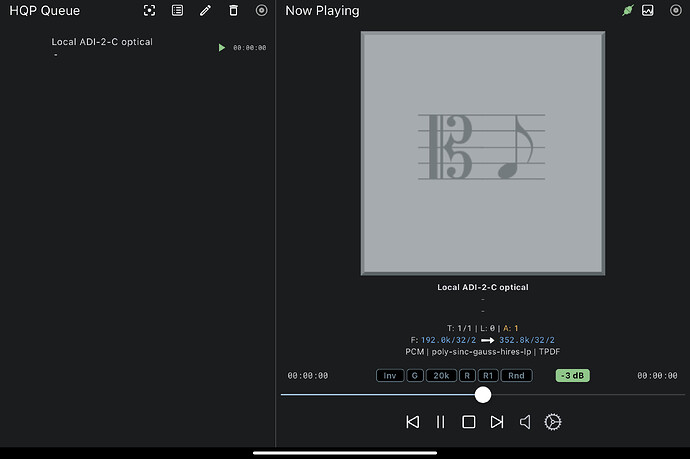^^ Thanks! For anyone that loves sinc-MGa but wishes it had more oomph sometimes - try it with the modulator: ASDM7EC-super. This could be the perfect/super connection. Enjoy!
I’ve just tried that modulator for the first time. My first impression was that the slight haziness/roundedness (I don’t mean to be fully negative, the flip side of that is that the interaction between sounds within the soundstage is nice, smooth and seamless) was addressed and the sound was very “tight” again.
But, after a few more moments of listening, I realised that the soundstage had changed substantially. Things got punchier, yes, but also pushed further away from me and as such I lost an emotional connection to music (it started being “presented to me” as opposed to me experiencing it). So it seems that whatever the “super” modulators are doing differently, I’m not a fan (although I’ll give it another listen later on).
I have an ESS DAC, so going by the manual I should be using a 5th order modulator, but I think that the 7th order ones sound better to my ears - “bigger”, more enveloping. Not sure if I’m doing my DAC an actual disservice by selecting 7th order instead of 5th.
I had small reservations about the Sinc-MGa to begin with but it seems like it’s quickly becoming my go-to filter. With real instruments, poly-sinc-gauss-xla might still sound more life-like, but on most recordings I care a lot about the spatial presentation and the MGa has pretty much the size of the stage of the Mx filter, but is smoother and it keeps surprising me how apparent the difference in holography of certain sounds is on some tracks! The Mx and L still pack more punch, but I think that the MGa filter is darn convincing as another step towards getting the “best of all worlds” (stage, timbre, transients).
^ Great thoughts. Listening to both modulators again with Sinc-MGa - I think they are both great…but I think the v3 might be the better one when listening at night or in a good listening environment. During the day or perhaps more sound around, I think super could be better as you’re getting more punch in the sound stage. Both are great because there are no harsh highs. But V3 does seem to do a great job of being super revealing of the full mix, nothing harsh, great soundstage, and everything feeling connected.
Topping D90 may not support 48k based DSD rates?
If so, that would explain why you need to uncheck
I also assume you tried ticking auto family rate, tick “48k DSD” and set DSD rate = 12288000
Congratulations @jussi_laako ! What are the filters?
You need ask Ferrum for any details regarding the device. I did some custom filters for it.
I am still smitten with the new Sinc-MGa filter and also quite intrigued as to why it sounds so different to other filters in terms of its airiness (even if at the cost of slightly less body/impact).
@jussi_laako Am I right in suspecting that despite the filter’s name, it is a fully Gaussian filter and except for the number of taps it doesn’t really have anything to do with the sinc family? This would explain the filter’s very distinct nature, i.e. very “free-flowing” sound presentation. It also loads just as quickly as the poly-sinc-gauss filters and uses about 20% of the RAM that the Sinc-Mx would use.
I have not been able to find another filter that would come close to Sinc-MGa’s “airiness”. I was going to call it “diffuse-sounding”, but it’s not really that as it doesn’t lose that much punch/body. It’s just spectacularly good at holography and presenting sounds in a 3D way. It’s less about the contours of sounds and much more about smoothness/seamlessness.
All of the above makes me think that this is a filter that is rather different from all the previous ones. My guess is that I associated its name with the sinc-Mx filter which led me to believe that this is the sinc version of the poly-sinc-gauss filter, but I don’t feel like that’s the case. The manual actually refers to the filter as “Gaussian constant time filter” and that’s yet another reason why I think that this is a purely Gaussian filter. Am I right? ![]()
It belongs to same group as poly-sinc-gauss, but with different implementation.
sinc-L is also completely different from sinc-S and sinc-M, or from sinc-MG.
Yes, it is different implementation of poly-sinc-gauss family.
Just tried v5.0 after happily been using v4.0 for close to 2 years. Directly tried sinc-MGa on DSD1024 and ASDM7ECv3 and I can say I was blown away with how good the combo was. I am fortunate enough to have RTX 4090 and 5800X3D on my gaming rig. as seen on the screenshot, it even barely puts a dent on both CPU and GPU utilization.
Your screenshot shows DSD256 not DSD1024
What DAC?
hmm you’re correct. probably the adaptive rate setting caused it. DAC is Sabaj D5 (using ES9038PRO D/A chip)
Good DAC but max rate is DSD512, not DSD1024 ?
Going to test out new version 5 tonight.
On DSD256 I’m using Poly Sinc Gauss Long and on Nx Poly Sinc Gauss Hi Res lp
Modulator ecv2
I’m reading that everyone is impressed with Sinc mga. Do I use this for Nx as well?
Worth checking the new modulators with your current filters too. When trying out, remember to change just one thing at a time.
Good to hear from you Jussi. I will be upgrading to 5 shortly. Picking up a pair of Fact 12’s on Saturday, so the HiFi funds will be a little depleted.
My honest feedback is that ASDM7ECv3 with Sinc MGa gives me a little too much sibilance and bass seems to be reduced. This is running DSD256 48x into a Holo May KTE with Avondale amplification and currently PMC Twenty 26’s.
ASDM7ECv3 with Poly-Sinc-Gauss-Long and Poly-Sinc-Gauss-HiReslp on nx is excellent as it is with ASDM7ECv2 with DSD256 48x
A lot will probably change when I hook up the Fact 12’s. I’ll let you know
All the best,
Mark
My latest thoughts with Modulator: ASDM7ECv3 running PCM upscaling to DSD at 48k x 256 max rate, thoughts on 1x filters:
poly-sinc-ext3 - this filter is incredible for acoustic and classical through my limited testing so far. I love how instruments sound like they are the very lifelike. I think it helps bring out the emotion of those type of music because a big part of the emotion is feeling the instruments.
sinc-MGa - this is turning into the great all arounder for me. I prefer perhaps the ext3 filter for those above 2 genres of music, but this MGa filter is still incredible at peering through the mix with incredible dynamics and soundstage with depth. MistaLova is much better at describing what this filter is doing and I completely agree. It’s doing something special. That holographic/smoothness seems to open a door to music that I love.
Both are great, and those are the 2 standout filters for me. I still gotta try more with hires. Do people use the gauss hires filters for Nx even if they like the above filters for 1x? What should I do? ha.
Hi Ray,
I use the the hires filters only for NX. My system is very neutral in terms of amplification and speakers….I like neutral and I’m more than happy with Poly-Sinc-Gauss-Long on 1x and Poly-Sinc-Gauss-HiReslp on NX. Everyone has different systems and different ears😀
New HQPDControl update. On iPad I can now see spectrogram.
Don’t need to interact with PC/Mac
Here feeding Amazon Music UHD to HQPlayer bit perfectly (via WiiM Mini → RME ADI-2 → HQPlayer input → HQPlayer output NAA DAC)
Press on the icon in top right:
Works on iPhone as well. ![]()
![]()
